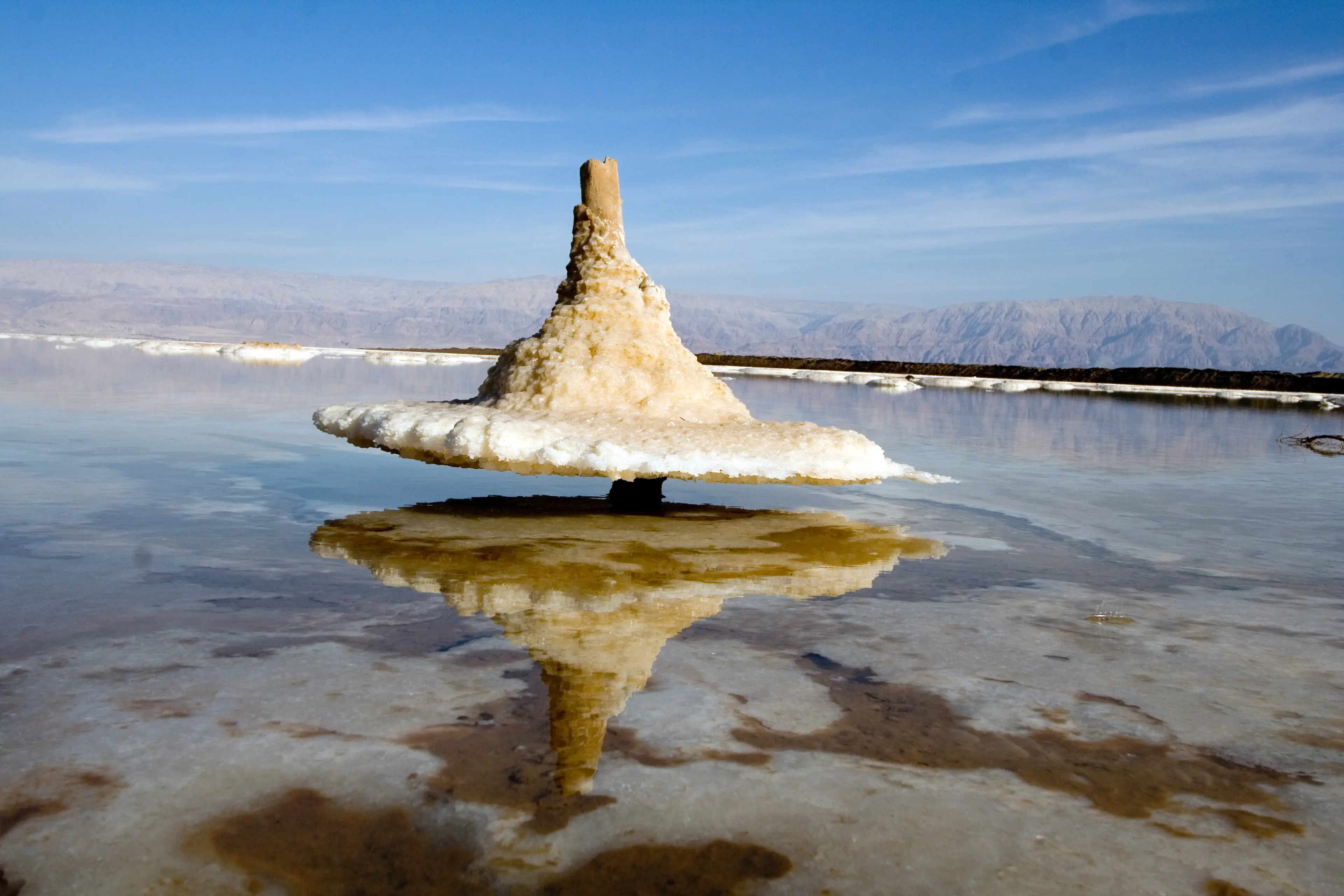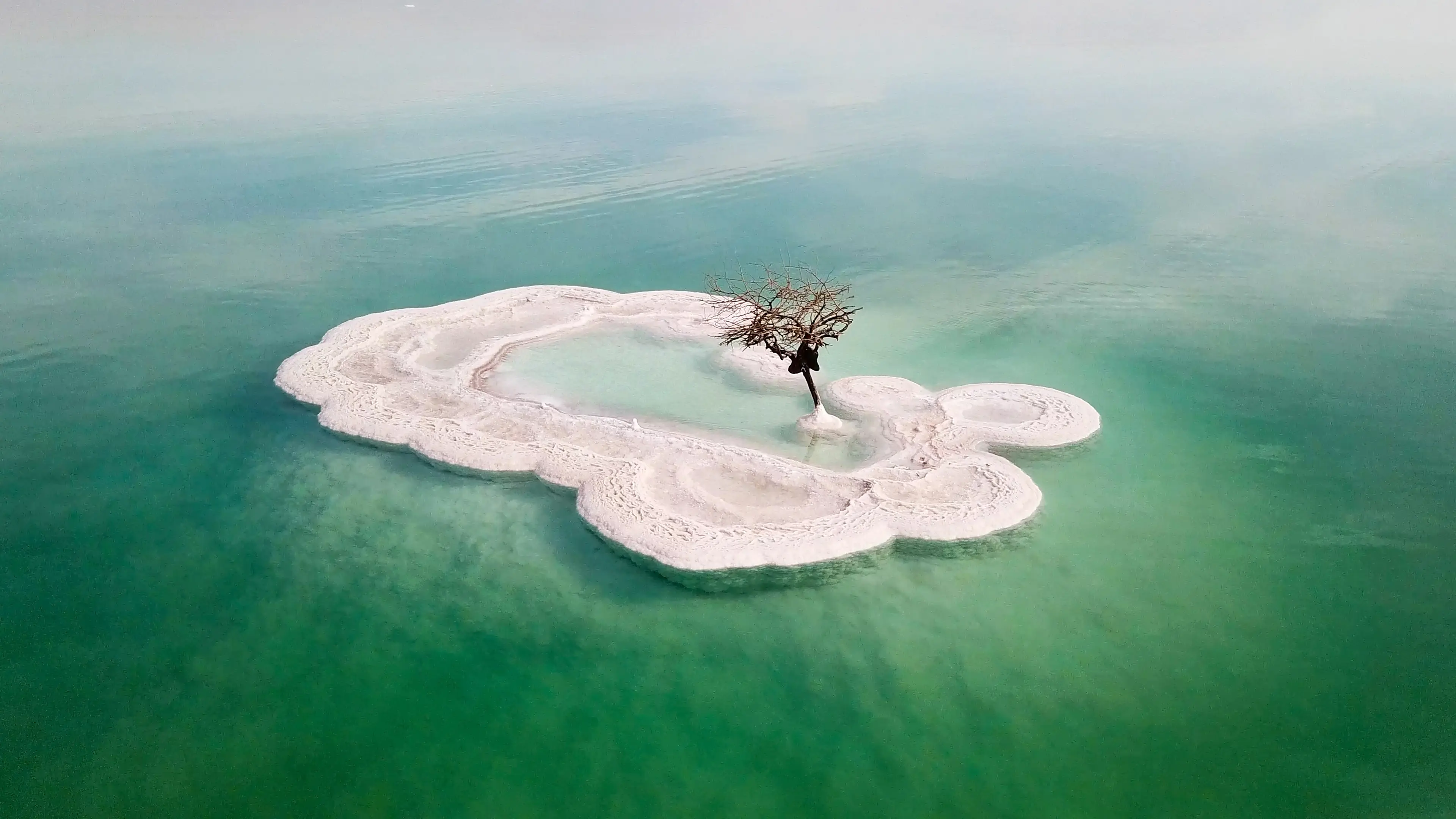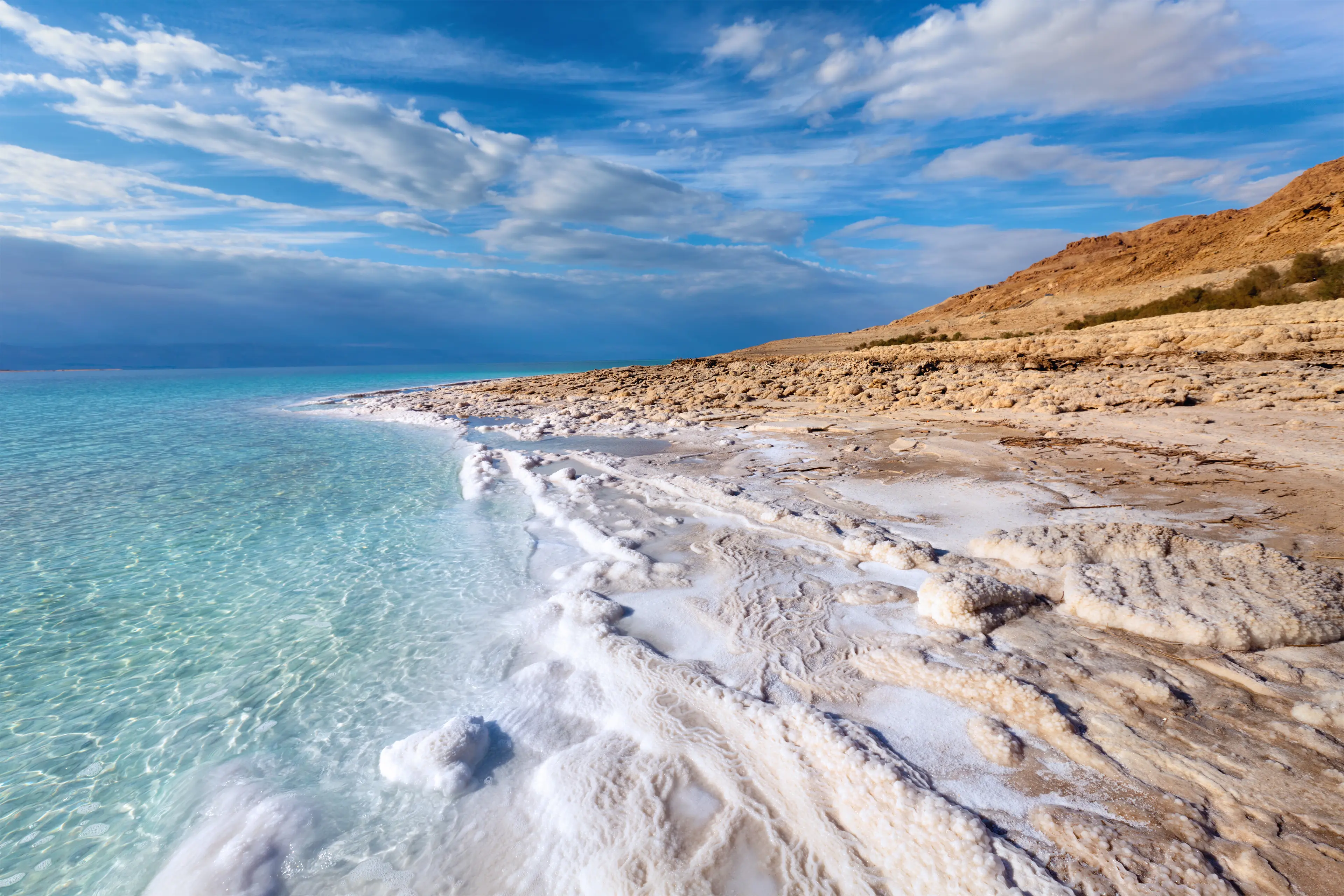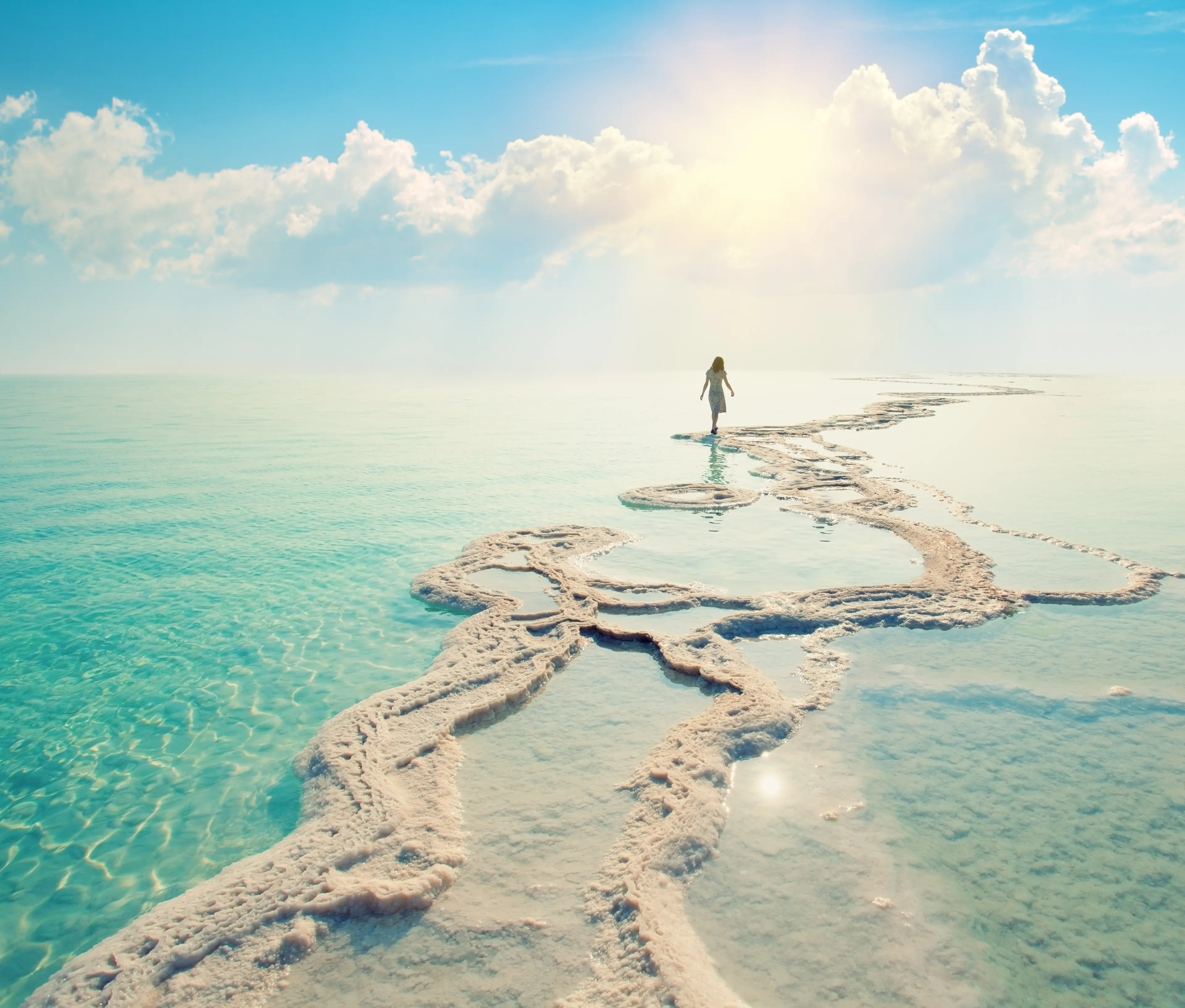Romantic One-Day Dead Sea Escape: Relaxation and Unique Experiences
The Dead Sea, Israel
1 days





About The Dead Sea, Israel
Experience the unique wonders of the Dead Sea, Israel. Known for its therapeutic properties, the Dead Sea offers a unique floating experience due to its high salt concentration. Immerse yourself in the mineral-rich mud, believed to have healing properties for various skin conditions. Explore the stunning Ein Gedi Nature Reserve nearby, with its diverse flora and fauna. Visit the ancient fortress of Masada, a UNESCO World Heritage Site, offering breathtaking views of the Dead Sea. Enjoy the serene desert landscape, rich history, and rejuvenating atmosphere. The Dead Sea, a natural wonder, is a must-visit destination for wellness, adventure, and history enthusiasts.
1-Day Itinerary
Attractions in Itinerary (3)

1Dead Sea
The Dead Sea is a salt lake bordered by Jordan to the east and Israel and the West Bank to the west. It is one of the world's saltiest bodies of water, with a salinity of 34.2%. It is 304 m (997 ft) deep, the deepest hypersaline lake in the world.

2Ein Gedi Nature Reserve
Ein Gedi Nature Reserve is a nature reserve in Israel, located west of the Dead Sea, near Masada and the Qumran Caves. The reserve is known for its diverse range of plant and wildlife species.

3Bedouin-style meal
A traditional meal enjoyed by the Bedouin people, typically consisting of lamb, rice, and vegetables, often cooked in a single pot. This is a unique cultural experience that allows visitors to taste the local cuisine and learn about the Bedouin way of life.
Local Food and Drinks (12)

Falafel
A deep-fried ball or patty made from ground chickpeas, fava beans, or both. It's a popular food in Israel, often served in a pita, which acts as a pocket, or wrapped in a flatbread known as lafa.

Hummus
A Levantine dip or spread made from cooked, mashed chickpeas blended with tahini, lemon juice, and garlic. It's a staple food in Israel and often served with pita bread.

Shakshuka
A dish of eggs poached in a sauce of tomatoes, chili peppers, and garlic, commonly spiced with cumin, paprika, cayenne pepper, and nutmeg. It's a typical breakfast dish in Israel.

Baba Ganoush
A Levantine appetizer of mashed cooked eggplant mixed with tahini, olive oil, possibly lemon juice, and various seasonings. It's a popular dish in Israel, often served as a starter or a dip.

Shawarma
A Middle Eastern meat preparation, where lamb, chicken, turkey, beef, veal, or mixed meats are placed on a spit, and may be grilled for as long as a day. It's a popular street food in Israel.

Israeli Salad
A chopped salad of finely diced tomato, onion, cucumber, and bell or chili peppers. It's a common dish in Israel, often served as a side dish to main meals.

Sabich
An Israeli sandwich, consisting of pita bread stuffed with fried eggplant and hard boiled eggs. It's a popular street food in Israel, especially in the area around the Dead Sea.

Burekas
A family of baked filled pastries made of a thin flaky dough, filled with cheese, spinach, potato, or meat. It's a common snack or breakfast food in Israel.

Jachnun
A Yemenite Jewish pastry, rolled out dough that is brushed with oil and baked overnight. It's a traditional Israeli breakfast food, often served with a crushed/grated tomato dip.

Arak
A Levantine alcoholic spirit, clear, colorless, unsweetened anise-flavored distilled alcoholic drink. It's a popular drink in Israel, often consumed with food.

Limonana
A refreshing drink made from fresh lemons, mint, sugar, and water. It's a popular non-alcoholic beverage in Israel, often served in hot summer days.

Turkish Coffee
A method of preparing unfiltered coffee, where finely powdered roast coffee beans are boiled in a pot. It's a common coffee preparation in Israel, often served after meals.
Best time to visit
The best time to visit the Dead Sea, Israel is during the spring (April and May) or autumn (September and October). During these periods, the weather is pleasantly warm with average temperatures ranging between 20°C to 30°C, making it ideal for floating in the salty waters and exploring the surrounding attractions. The summer months (June to August) can be extremely hot, with temperatures often exceeding 40°C, which might be uncomfortable for some tourists. Winter (November to March) is cooler and can sometimes see rainfall, which might disrupt outdoor activities.
How to get around
Car Rental
Renting a car is a popular option for getting around in the Dead Sea region. There are several car rental companies available at the airport and in major cities. This gives you the freedom to explore the area at your own pace. Remember to drive on the right side of the road in Israel.
Taxi
Taxis are readily available in the Dead Sea region. They are a convenient way to get to specific destinations, especially if you're not familiar with the area. Most taxi drivers speak English, making communication easier.
Ridesharing
Ridesharing services such as Uber and Gett are available in Israel. These can be a cost-effective and convenient way to get around, especially if you're traveling in a group. You can book a ride using the respective apps.
Public Bus
Public buses are a common mode of transport in Israel. Egged, the national bus company, operates routes to the Dead Sea from major cities like Jerusalem and Tel Aviv. Buses are usually comfortable and air-conditioned.
Private Tour
Private tours are a great way to explore the Dead Sea region. These tours often include transportation, a guide, and visits to key attractions. This is a hassle-free way to experience the Dead Sea, as the tour operator takes care of all the logistics.
Bicycle
The Dead Sea region is relatively flat, making it ideal for cycling. There are several places where you can rent bicycles. This is a fun and eco-friendly way to explore the area.
Foot
The Dead Sea area is not very large, so it's possible to explore some parts of it on foot. This is especially true for the resort areas and the natural attractions close to the hotels. Walking allows you to take in the beautiful scenery at your own pace.
Important information
Currency₪ ILS
Time zoneUTC+2
Driving sideRight
Emergency phoneAmbulance: 101; Fire: 102; Police: 100
Drinking waterYes, but many opt for bottled water
Power sockets
Voltage230 V
Things to know about The Dead Sea, Israel as a first time visitor
1
The Dead Sea is not a sea but a salt lake bordering Jordan to the east, and Israel and Palestine to the west.
2
The Dead Sea is the lowest point on earth, sitting 429 meters below sea level.
3
The water in the Dead Sea is extremely salty, with a salinity of about 34%, which is almost ten times saltier than normal sea water.
4
Due to the high salt content, it is impossible to sink in the Dead Sea. You can easily float on the surface of the water.
5
The mud and clay along the shores of the Dead Sea are rich in minerals and are believed to have therapeutic properties. Many visitors apply the mud to their skin for health benefits.
6
The Dead Sea is renowned for its healing properties, particularly for skin diseases like psoriasis and eczema.
7
The climate at the Dead Sea is warm and sunny all year round. The average temperature in summer (June to August) is around 86-104°F (30-40°C) and in winter (December to February) it's around 68-77°F (20-25°C).
8
Despite the high temperatures, the Dead Sea area has a relatively low humidity, making the heat more bearable.
9
The water and air around the Dead Sea are highly filtered of allergens and pollens due to the high concentration of minerals, making it a great destination for those with respiratory issues.
10
The UV rays at the Dead Sea are weaker due to its low altitude, making sunbathing safer. However, it's still important to use sun protection.
11
There are no fish or any kind of swimming, squirming creatures living in or near the water. The high salt concentration does not allow any life form to survive.
12
It's not advisable to shave a day or two before visiting the Dead Sea. The high salt content can cause stinging on freshly shaved skin.
13
Avoid getting the water in your eyes or mouth, as it can be very painful and unpleasant due to the high salt content.
14
There are several public beaches along the Dead Sea where you can access the water. Some of these beaches may charge an entrance fee.
15
The Dead Sea is rapidly shrinking at a rate of about 1 meter per year. This is causing sinkholes to appear in the area, so always stick to marked paths.
16
There are no facilities for swimming in the traditional sense. You won't find any diving or jumping areas due to the nature of the water.
17
It's recommended to wear water shoes or sandals when walking in or near the water, as the salt formations can be sharp.
18
After bathing in the Dead Sea, it's important to rinse off the salt and minerals with fresh water to avoid skin irritation.
19
Drinking plenty of water is essential when visiting the Dead Sea due to the high temperatures and the dehydrating effect of the salt water.
20
The Dead Sea region is quite remote, so it's advisable to bring any essentials with you, including water, snacks, sunblock, and towels.
Basic Hebrew to know as a first time visitor
English phrase | Native phrase | Pronunciation | When to use it |
|---|---|---|---|
Hello | שלום | Shalom | Greeting someone |
Goodbye | להתראות | Lehitraot | Leaving or saying goodbye |
Please | בבקשה | Bevakasha | Making a request |
Thank you | תודה | Toda | Expressing gratitude |
Yes | כן | Ken | Agreeing or affirming |
No | לא | Lo | Disagreeing or negating |
Excuse me | סליחה | Slicha | Getting attention or apologizing |
I don't understand | אני לא מבין | Ani lo mevin | When you don't understand something |
Do you speak English? | אתה מדבר אנגלית? | Ata medaber anglit? | When you need to communicate in English |
Where is the bathroom? | איפה השירותים? | Eifo ha'sherutim? | When you need to use the restroom |
How much does this cost? | כמה זה עולה? | Kama ze oleh? | When you want to know the price of something |
I need a doctor | אני צריך רופא | Ani tzarich rofe | In case of a medical emergency |
Help | עזרה | Ezra | In case of an emergency |
Water | מים | Mayim | When you want to order water |
Food | אוכל | Ochel | When you want to order food |
Hotel | מלון | Malon | When you need to find a hotel |
Taxi | מונית | Monit | When you need a taxi |
Airport | נמל התעופה | Namal te'ufa | When you need to find the airport |
Beach | חוף | Chof | When you want to go to the beach |
Dead Sea | ים המלח | Yam ha'melach | When you want to go to the Dead Sea |
Packing List
Clothing
Lightweight clothing
Swimwear
Water shoes
Hat
Sunglasses
Sun-protective clothing
Change of clothes
Toiletries
Sunscreen
Lip balm with SPF
Insect repellent
Personal hygiene items
Towels
First aid kit
Travel documents and essentials
Passport
Driver's license/ID
Health insurance card
Travel insurance documents
Hotel reservation confirmation
Credit cards
Cash (Israeli Shekels)
Electronics and gadgets
Smartphone
Camera
Portable charger
Headphones
Travel adapter
Miscellaneous items
Water bottle
Snacks
Travel guidebook
Map
Backpack
Plastic bags for wet clothes
Weather Conditions
Visiting the Dead Sea in Israel can be a unique and exciting experience, but it's important to consider the weather conditions to make the most of your trip. The region is characterized by a desert climate, meaning it's typically hot and dry, especially in the summer months from June to August. During this period, temperatures can soar up to 104°F (40°C), so it's crucial to stay hydrated and protected from the sun. If you're not a fan of extreme heat, consider visiting during the spring or autumn. In these seasons, temperatures are more moderate, typically ranging between 68°F to 86°F (20°C to 30°C). However, even in these seasons, the sun can be quite strong, so don't forget your sunblock, hat, and sunglasses. Winter, from December to February, can be surprisingly cool with temperatures dropping to around 50°F (10°C). While it's still possible to float in the Dead Sea during this time, you might find the air a bit chilly, especially in the evenings. Regardless of when you visit, remember that the Dead Sea region is very sunny. It's recommended to wear UV-protective clothing and regularly apply a high-factor sunscreen, even on cloudy days, as UV rays can penetrate through clouds. Also, due to the high salt content in the water, it's advisable to wear water shoes to protect your feet. Lastly, keep in mind that the weather can change quickly in desert areas. It's always a good idea to check the local forecast before planning your day and pack layers to accommodate fluctuating temperatures.
| Month | Hi / Lo (°C) | Weather Overview |
|---|---|---|
January | 18° / 8° | January is the coldest month in the Dead Sea, with temperatures ranging from 8 to 18 degrees Celsius. It's a good time to visit if you prefer cooler weather. |
February | 20° / 10° | In February, temperatures start to rise slightly, making it a pleasant time for outdoor activities. The average temperature ranges from 10 to 20 degrees Celsius. |
March | 23° / 13° | March sees a further increase in temperature, with averages between 13 and 23 degrees Celsius. It's a great time for swimming and sunbathing. |
April | 27° / 17° | April is warm with temperatures ranging from 17 to 27 degrees Celsius. It's an ideal time for water activities and exploring the surrounding areas. |
May | 30° / 20° | May is quite hot with temperatures between 20 and 30 degrees Celsius. It's perfect for those who enjoy the heat and want to spend time in the water. |
June | 33° / 23° | June is one of the hottest months in the Dead Sea, with temperatures ranging from 23 to 33 degrees Celsius. Make sure to stay hydrated and protect yourself from the sun. |
July | 35° / 25° | July is the peak of summer with temperatures between 25 and 35 degrees Celsius. It's a great time for swimming in the sea, but avoid prolonged exposure to the sun. |
August | 35° / 25° | August is equally hot as July, with temperatures ranging from 25 to 35 degrees Celsius. It's a good time for indoor activities or relaxing by the sea in the early morning or late evening. |
September | 33° / 23° | September sees a slight decrease in temperature, with averages between 23 and 33 degrees Celsius. It's a great time for outdoor activities and exploring the Dead Sea region. |
October | 30° / 20° | October is a pleasant month with temperatures ranging from 20 to 30 degrees Celsius. It's an ideal time for sightseeing and enjoying the natural beauty of the area. |
November | 25° / 15° | November is cooler with temperatures between 15 and 25 degrees Celsius. It's a good time for hiking and exploring the surrounding areas. |
December | 20° / 10° | December is the second coldest month in the Dead Sea, with temperatures ranging from 10 to 20 degrees Celsius. It's a good time to visit if you prefer cooler weather. |
Did you know?
Places near by The Dead Sea, Israel

Masada
An ancient fortress in southern Israel’s Judean Desert.

Ein Gedi Nature Reserve
A nature reserve and national park known for its stunning beauty and diverse wildlife.

Jerusalem
The capital city of Israel, known for its rich history and religious significance.

Petra
A historical and archaeological city in southern Jordan.

Tel Aviv
A vibrant city on Israel's Mediterranean coast.

Amman
The capital of Jordan, known for its ancient ruins and modern buildings.

Bethlehem
A Palestinian city located in the central West Bank, known as the birthplace of Jesus.

Haifa
A northern Israeli port city built in tiers extending from the Mediterranean up the north slope of Mount Carmel.

Aqaba
A Jordanian port city on the Red Sea's Gulf of Aqaba.

Eilat
Israel's southernmost city, a busy port and popular resort, located at the northern tip of the Red Sea.